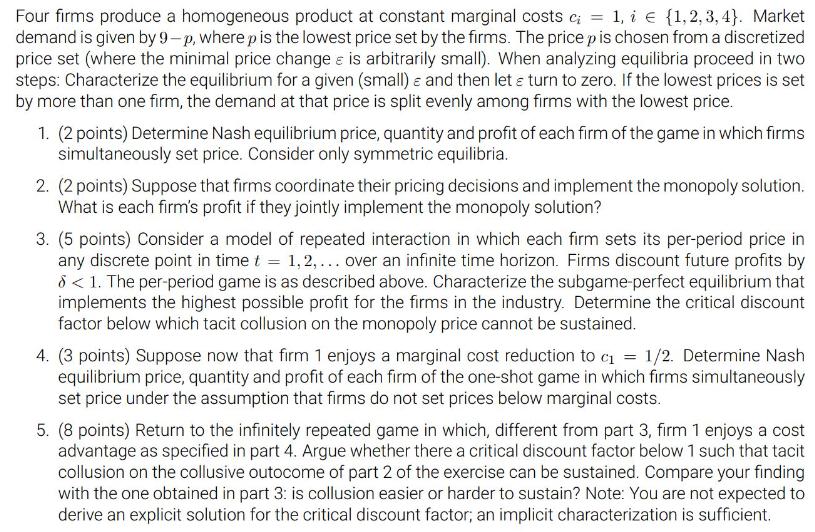Answered step by step
Verified Expert Solution
Question
1 Approved Answer
Four firms produce a homogeneous product at constant marginal costs c; = 1, ie (1,2,3,4}. Market demand is given by 9-p, where p is

Four firms produce a homogeneous product at constant marginal costs c; = 1, ie (1,2,3,4}. Market demand is given by 9-p, where p is the lowest price set by the firms. The price p is chosen from a discretized price set (where the minimal price change = is arbitrarily small). When analyzing equilibria proceed in two steps: Characterize the equilibrium for a given (small) = and then let & turn to zero. If the lowest prices is set by more than one firm, the demand at that price is split evenly among firms with the lowest price. 1. (2 points) Determine Nash equilibrium price, quantity and profit of each firm of the game in which firms simultaneously set price. Consider only symmetric equilibria. 2. (2 points) Suppose that firms coordinate their pricing decisions and implement the monopoly solution. What is each firm's profit if they jointly implement the monopoly solution? 3. (5 points) Consider a model of repeated interaction in which each firm sets its per-period price in any discrete point in time t = 1,2,... over an infinite time horizon. Firms discount future profits by 8 < 1. The per-period game is as described above. Characterize the subgame-perfect equilibrium that implements the highest possible profit for the firms in the industry. Determine the critical discount factor below which tacit collusion on the monopoly price cannot be sustained. 4. (3 points) Suppose now that firm 1 enjoys a marginal cost reduction to c = 1/2. Determine Nash equilibrium price, quantity and profit of each firm of the one-shot game in which firms simultaneously set price under the assumption that firms do not set prices below marginal costs. 5. (8 points) Return to the infinitely repeated game in which, different from part 3, firm 1 enjoys a cost advantage as specified in part 4. Argue whether there a critical discount factor below 1 such that tacit collusion on the collusive outocome of part 2 of the exercise can be sustained. Compare your finding with the one obtained in part 3: is collusion easier or harder to sustain? Note: You are not expected to derive an explicit solution for the critical discount factor; an implicit characterization is sufficient.
Step by Step Solution
★★★★★
3.42 Rating (152 Votes )
There are 3 Steps involved in it
Step: 1
Part 1 Nash equilibrium in the oneshot game 11 Equilibrium price and quantity Since the firms have the same marginal cost they will set the same price Let this be p To maximize profits each firm will ...
Get Instant Access to Expert-Tailored Solutions
See step-by-step solutions with expert insights and AI powered tools for academic success
Step: 2

Step: 3

Ace Your Homework with AI
Get the answers you need in no time with our AI-driven, step-by-step assistance
Get Started


